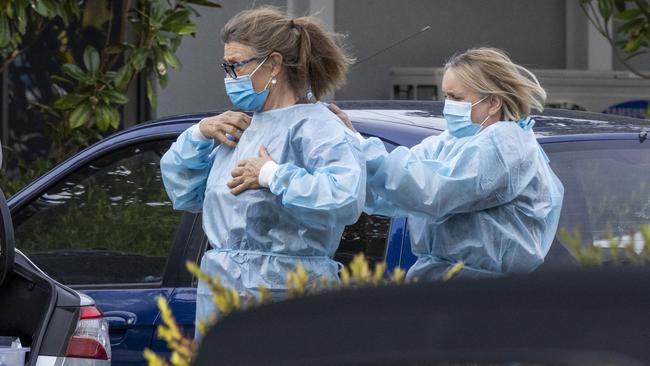PPE about-face on airborne protection
The nation’s top infection control experts have advised healthcare workers to wear airborne protection in high-risk Covid areas.

The nation’s top infection control experts have advised healthcare workers to wear airborne protection when working in environments that place them at high risk of contracting Covid-19, in a major overhaul of guidelines that followed weeks of negotiations among top doctors.
The Infection Control Expert Group responded to recommendations put forward by the National COVID-19 Clinical Evidence Taskforce that emphasised airborne transmission of Covid-19 amid wide consensus in the medical and scientific community that droplet precautions were insufficient to protect healthcare workers from contracting the virus.
Key members of ICEG have for more than a year been resisting calls to update guidelines that advised healthcare workers that wearing a surgical mask was sufficient even when dealing with suspected or positive Covid-19 patients, except in a narrow set of specific circumstances.
In recent months, the clinical taskforce, which included the nation’s top medical colleges, societies, associations and foundations, formulated consensus guidelines that forced ICEG’s hand in overturning official commonwealth infection control advice.
The federal health department released a statement on Thursday announcing that ICEG and the Taskforce had jointly agreed on updated recommendations to protect healthcare workers from Covid-19 infection.
“The updated recommendations are the result of a significant body of work and reflect a balanced risk approach to protecting healthcare workers from Covid-19,” the statement said.
ICEG’s new guidelines stipulate that “healthcare workers providing direct care or working within the patient/client/resident zone for individuals where assessment suggests a high-risk of transmission, should use P2/N95 respirators rather than face masks, along with the other PPE required”.
In situations that fall short of being classified as “likely high risk” of virus transmission, the guidelines state that all healthcare workers providing direct patient care or working in proximity to individuals with suspected or confirmed Covid-19 “should have access to P2/N95 respirators”.
The old guidelines advised that healthcare workers should use N95 respirators for so-called aerosol-generating procedures and “may consider” the use of an N95 respirator in specified settings including emergency departments, residential care facilities and Covid-19 wards, but only when there was a risk patients could exhibit “challenging behaviours” or there was the risk of “unplanned aerosol-generating procedures”.
The Australian Medical Association on Thursday said the new guidelines “could not have come soon enough”. “Too many healthcare workers in Australia have been placed at risk of Covid-19 because of the lack of adequate PPE,” it said.
Benjamin Veness, a spokesperson for the group Health Care Workers Australia, said the new guidelines were a good start but there was still an urgent need for a much wider suite of changes to ventilation protocols.
“One implicit assumption in the guidance is that Covid-19 transmits through the airborne route, but it’s disappointing that wasn’t made more explicit,” Dr Veness said. “If that were to be made more explicit, what should have followed were recommendations relating to the built environment.
“That’s particularly important because what this new document covers is solely staff and patient interactions. There’s nothing in it about staff to staff interactions, yet we know that things like tea rooms or small offices where staff are all working in very close quarters together, often with poor ventilation, are high-risk areas.”
Suzy Nou, the president of the Australian Society of Anaesthetists, labelled the previous guidelines “rubbish”.
“Recommending surgical masks for something that has got airborne transmission does not make sense,” Dr Nou said.
“Victoria already changed the guidance quite sensibly and it was just a shame that it took so long for the national guidance to change.
“I think this really to me speaks to the composition of ICEG - that there’s just a huge lack of professional diversity in the members of the people who compose ICEG. There’s been an incredible amount of distress in the past year with healthcare workers going to work and not feeling that their safety was valued.”
Dr Nou said many healthcare workers had felt “gaslighted” by the peak infection control body.
“Early in the pandemic prominent people have said there’s no airborne transmission and then later in the pandemic they’ve said we’ve always acknowledged airborne transmission.
“They’ve been kind of gaslighting us with regards to their statements about airborne transmission. We’ve been saying if it’s been airborne all along why don’t you recognise airborne precautions? Here we are in June and they’ve finally recommending airborne precautions, so it is a watershed.”




To join the conversation, please log in. Don't have an account? Register
Join the conversation, you are commenting as Logout